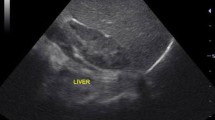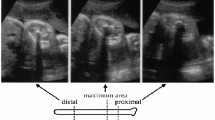Abstract
Objective
To create a nomogram for fetal splenic circumference of normal fetuses.
Materials and methods
A prospective, cross-sectional study was undertaken on normal pregnancies with certain date from 14 to 40 weeks of gestation. All fetuses were measured for fetal splenic circumference by tracing technique on transverse view of the fetal abdomen, using high-resolution real-time ultrasound with a 2–4 MHz convex transducer.
Results
A total of 684 normal pregnant women between 14 and 40 weeks of gestation were recruited. Fifty-eight were excluded because of poor image quality and fetal abnormality. The remaining 626 were available for analysis. Quadratic equation model was best fitted to estimate the 5th, 50th and 95th percentile range of splenic circumference at each gestational week. Fetal splenic circumference was gradually increased with gestational age with fitted equation as follows: splenic circumference (cm) = −4.181 + 0.456 (GA) −0.001 (GA)2 (r = 0.942, p < 0.001). The table of nomogram for various percentile ranges was constructed.
Conclusion
A normal reference range of fetal splenic circumference for each week of gestational age during 14–40 weeks is established.


Similar content being viewed by others
References
Oepkes D, Meerman RH, Vandenbussche FP, van Kamp IL, Kok FG, Kanhai HH (1993) Ultrasonographic fetal spleen measurements in red blood cell-alloimmunized pregnancies. Am J Obstet Gynecol 169:121–128
Bahado-Singh R, Oz U, Mari G, Jones D, Paidas M, Onderoglu L (1998) Fetal splenic size in anemia due to Rh-alloimmunization. Obstet Gynecol 92:828–832
Schmidt W, Yarkoni S, Jeanty P, Grannum P, Hobbins JC (1985) Sonographic measurements of the fetal spleen: clinical implications. J Ultrasound Med 4:667–672
Lam YH, Ghosh A, Tang MH, Lee CP, Sin SY (1997) Second-trimester hydrops fetalis in pregnancies affected by homozygous alpha-thalassaemia-1. Prenat Diagn 17:267–269
Lam YH, Tang MH, Lee CP, Tse HY (1999) Prenatal ultrasonographic prediction of homozygous type 1 alpha-thalassemia at 12 to 13 weeks of gestation. Am J Obstet Gynecol 180(1 Pt 1):148–150
Chawanpaiboon S, Titapant V, Sutantawibul A, Kanokpongsakdi S, Kangkagate C (2005) Predicting fetal anemia by using reference centile charts for liver length, spleen perimeter and umbilical vein maximum flow velocity in Thai fetuses throughout gestation. J Obstet Gynaecol Res 31:547–551
Lai FM, Yeo GS (1995) Reference charts of foetal biometry in Asians. Singapore Med J 36:628–636
Lei H, Wen SW (1998) Ultrasonographic examination of intrauterine growth for multiple fetal dimensions in a Chinese population. Central-South China Fetal Growth Study Group. Am J Obstet Gynecol 178:916–921
Aoki S, Hata T, Kitao M (1992) Ultrasonographic assessment of fetal and neonatal spleen. Am J Perinatol 9:361–367
Hata T, Aoki S, Takamori H, Hata K, Murao F, Kitao M (1987) Ultrasonographic in utero identification and measurement of the normal fetal spleen. Gynecol Obstet Invest 23:124–128
Leung WC, Oepkes D, Seaward G, Ryan G (2002) Serial sonographic findings of four fetuses with homozygous alpha-thalassemia-1 from 21 weeks onwards. Ultrasound Obstet Gynecol 19:56–59
Tongsong T, Wanapirak C, Srisomboon J, Piyamongkol W, Sirichotiyakul S (1996) Antenatal sonographic features of 100 alpha-thalassemia hydrops fetalis fetuses. J Clin Ultrasound 24:73–77
Hata T, Kuno A, Dai SY, Inubashiri E, Hanaoka U, Kanenishi K et al (2007) Three-dimensional sonographic volume measurement of the fetal spleen. J Obstet Gynaecol Res 33:600–605
Acknowledgments
The authors wish to thank the Thailand Research Fund (TRF) and the Commission on Higher Education (CHE) of Thailand, as a part of TRF Senior Research Scholar 2007 for financially supporting the conduct of this research (Grant no. RTA5080011).
Conflict of interest statement
None.
Author information
Authors and Affiliations
Corresponding author
Rights and permissions
About this article
Cite this article
Srisupundit, K., Piyamongkol, W., Tongprasert, F. et al. Reference range of fetal splenic circumference from 14 to 40 weeks of gestation. Arch Gynecol Obstet 283, 449–453 (2011). https://doi.org/10.1007/s00404-010-1375-7
Received:
Accepted:
Published:
Issue Date:
DOI: https://doi.org/10.1007/s00404-010-1375-7




